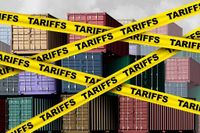Pakistani textile exporters are currently grappling with the implications of a significant 29 percent tariff imposed by the United States, a move that business leaders argue could disrupt the nation’s already fragile economy while potentially opening the door to new market opportunities. The tariff, announced by President Trump on April 1, 2025, is part of a broader wave of trade restrictions that have driven U.S. import duties to their highest levels in a century.
Emerging markets, which are already strained by weak currencies and heavy debt burdens, are expected to face sharp economic headwinds as a result of these new duties. The tariff affects a wide range of goods, hitting some of the world’s poorest nations particularly hard. For instance, tariffs on Madagascar’s vanilla have risen to 47 percent, while Sri Lankan textiles now face a 44 percent levy.
Pakistan, whose textile exports to the United States exceed $4 billion annually, is now facing a 29 percent tariff on its goods. Industry leaders warn that this increase could inflate prices and reduce competitiveness in one of the country’s largest export markets. Khalid Riaz, senior vice president of the Sindh Industrial Trading Estate in Karachi, expressed concern, stating, “This tariff could lead to instability in the economy. It raises the cost of our exports to the U.S. by 29 percent. But the tariff on India and China is even higher, so there might be a window of opportunity for us to gain some market share.”
Other exporters have echoed these concerns regarding the long-term consequences of the tariff. Abdul Qadir Bilwani, a Karachi-based exporter, noted, “Pakistan’s textile exports are heavily dependent on the U.S. market. Given our ongoing currency issues and a trade deficit that has only recently narrowed, this will hit us hard.”
While some African and Latin American countries have managed to escape the worst of the tariff increases — for example, Kenya faces a mere 10 percent duty and has touted the move as a “competitive advantage” — Asia appears to be disproportionately affected. Investors and analysts have warned that the full impact of the tariffs remains unclear, suggesting that the measures could unsettle global supply chains and exacerbate financial pressures on developing economies. Many had been hoping to attract new investment after years of stagnation.
“The effects of this shift in global trade policy are unprecedented in the modern era,” stated one regional economist. “We’re entering uncertain territory.”
In a similar vein, Indian seafood exporters are also feeling the sting of new tariffs, specifically a 26 percent duty imposed by the United States. This move has prompted exporters and farmers to analyze the impact of the new tariff regime, as the U.S. has been their biggest export destination for many years. Fortunately, exporters have noted that consignments already in transit will be exempt from the new import duty, which helps prevent financial losses and delays in delivery.
“The critical issue is that a portion of seafood exports sent to Southeast Asian countries, including Vietnam and Thailand, where they are re-exported to the U.S. after value addition, will be affected by the higher tariffs imposed on imports from these countries,” remarked KN Raghavan, secretary general of the Seafood Exporters Association of India. He expressed concern that the timing of the tariff imposition coincides with the beginning of the current season, just as farmers, processors, and other stakeholders in the chain prepare for shrimp cultivation.
There are fears that India may lose a portion of its market to Ecuador, which is geographically closer to the U.S. and faces a lower import duty of just 10 percent. In FY24, India’s seafood exports to the U.S. were valued at $2.54 billion, out of a total of $7.38 billion in exports. Notably, frozen shrimp continues to be the principal item exported to the U.S., representing close to 92 percent of the total seafood exports.
Over 41 percent of India’s shrimp exports went to America in FY24, making it by far the largest market for Indian seafood. The reciprocal tariff of 26 percent also covers major exporters to the U.S. shrimp market, including Ecuador (10 percent), Vietnam (46 percent), and Indonesia (32 percent). Divya Kumar Gulati, chairman of the Compound Livestock Feed Manufacturers Association, pointed out that while the shrimp industry would be impacted, other sectors such as poultry, dairy, and aquaculture may find opportunities to capitalize on shifting global trade dynamics, as other countries face similar or higher tariffs.
Meanwhile, discussions are ongoing regarding India’s plans to reduce its unusually high import duties on several agricultural products. These products include rice (70 percent), wheat (40 percent), food preparation (150 percent), walnuts (100 percent), and dairy products like cheese and skimmed milk powder (30-60 percent). Ricky Thapar, joint secretary of the Poultry Federation of India, emphasized that any reduction in import duties on chicken legs should be carefully considered, taking into account the health of the domestic poultry industry, which has been witnessing around 8 percent growth annually over the last decade.
Dairy industry sources have also raised concerns about the high import duties on skimmed milk powder, as millions of farmers in India typically have an average herd size of just 2-3 animals, compared to an average herd size of 500 animals in major milk-producing countries like the USA, Australia, and New Zealand. This disparity significantly reduces their cost of production.
As the global trade landscape continues to evolve, both Pakistani and Indian exporters are left to navigate the uncertain waters created by these new tariffs. While challenges abound, some see glimmers of opportunity on the horizon, highlighting the complex interplay of global trade dynamics.





